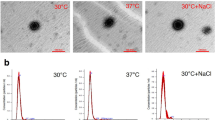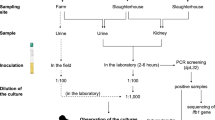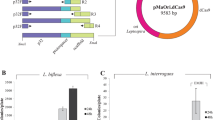Abstract
Leptospirosis is a widespread zoonotic disease caused by pathogenic spirochetes of the genus Leptospira that infects humans and a wide range of animals. By combining computational prediction and high-accuracy tandem mass spectra, we revised the genome annotation of Leptospira interrogans serovar Lai, a free-living pathogenic spirochete responsible for leptospirosis, providing substantial peptide evidence for novel genes and new gene boundaries. Subsequently, we presented a high-coverage proteome analysis of protein expression and multiple posttranslational modifications (PTMs). Approximately 64.3% of the predicted L. interrogans proteins were cataloged by detecting 2 540 proteins. Meanwhile, a profile of multiple PTMs was concurrently established, containing in total 32 phosphorylated, 46 acetylated and 155 methylated proteins. The PTM systems in the serovar Lai show unique features. Unique eukaryotic-like features of L. interrogans protein modifications were demonstrated in both phosphorylation and arginine methylation. This systematic analysis provides not only comprehensive information of high-coverage protein expression and multiple modifications in prokaryotes but also a view suggesting that the evolutionarily primitive L. interrogans shares significant similarities in protein modification systems with eukaryotes.
Similar content being viewed by others
Log in or create a free account to read this content
Gain free access to this article, as well as selected content from this journal and more on nature.com
or
References
Levett PN . Leptospirosis. Clin Microbiol Rev 2001; 14:296–326.
WHO. Leptospirosis worldwide, 1999. Wkly Epidemiol Rec 1999; 74:237–242.
Ren SX, Fu G, Jiang XG, et al. Unique physiological and pathogenic features of Leptospira interrogans revealed by whole-genome sequencing. Nature 2003; 422:888–893.
Nascimento AL, Ko AI, Martins EA, et al. Comparative genomics of two Leptospira interrogans serovars reveals novel insights into physiology and pathogenesis. J Bacteriol 2004; 186:9.
Bulach DM, Zuerner RL, Wilson P, et al. Genome reduction in Leptospira borgpetersenii reflects limited transmission potential. Proc Natl Acad Sci USA 2006; 103:14560–14565.
Picardeau M, Bulach DM, Bouchier C, et al. Genome sequence of the saprophyte Leptospira biflexa provides insights into the evolution of Leptospira and the pathogenesis of Leptospirosis. PLoS ONE 2008; 3:e1607.
Qin JH, Sheng YY, Zhang ZM, et al. Genome-wide transcriptional analysis of temperature shift in L. interrogans serovar Lai strain 56601. BMC Microbiol 2006; 6:51.
Lo M, Bulach DM, Powell DR, et al. Effects of temperature on gene expression patterns in Leptospira interrogans serovar Lai as assessed by whole-genome microarrays. Infect Immun 2006; 74:5848–5859.
Cullen PA, Cordwell SJ, Bulach DM, Haake DA, Adler B . Global analysis of outer membrane proteins from Leptospira interrogans serovar Lai. Infect Immun 2002; 70:2311–2318.
Nally JE, Whitelegge JP, Aguilera R, et al. Purification and proteomic analysis of outer membrane vesicles from a clinical isolate of Leptospira interrogans serovar Copenhageni. Proteomics 2005; 5:144–152.
Nally JE, Whitelegge JP, Bassilian S, Blanco DR, Lovett MA . Characterization of the outer membrane proteome of Leptospira interrogans expressed during acute lethal infection. Infect Immun 2007; 75:766–773.
Guerreiro H, Croda J, Flannery B, et al. Leptospiral proteins recognized during the humoral immune response to leptospirosis in humans. Infect Immun 2001; 69:4958–4968.
Sakolvaree Y, Maneewatch S, Jiemsup S, et al. Proteome and immunome of pathogenic Leptospira spp. revealed by 2DE and 2DE-immunoblotting with immune serum. Asian Pac J Allergy Immunol 2007; 25:53–73.
Malmstrom J, Beck M, Schmidt A, et al. Proteome-wide cellular protein concentrations of the human pathogen Leptospira interrogans. Nature 2009; 460:762–765.
Ishino Y, Okada H, Ikeuchi M, Taniguchi H . Mass spectrometry-based prokaryote gene annotation. Proteomics 2007; 7:4053–4065.
de Souza GA, Malen H, Softeland T, et al. High accuracy mass spectrometry analysis as a tool to verify and improve gene annotation using Mycobacterium tuberculosis as an example. BMC Genomics 2008; 9:316.
Tanner S, Shen Z, Ng J, et al. Improving gene annotation using peptide mass spectrometry. Genome Res 2007; 17:231–239.
Polevoda B, Sherman F . Methylation of proteins involved in translation. Mol Microbiol 2007; 65:590–606.
Wehenkel A, Bellinzoni M, Grana M, et al. Mycobacterial Ser/Thr protein kinases and phosphatases: physiological roles and therapeutic potential. Biochim Biophys Acta 2008; 1784:193–202.
Bendt AK, Burkovski A, Schaffer S, et al. Towards a phosphoproteome map of Corynebacterium glutamicum. Proteomics 2003; 3:1637–1646.
Pawson T, Scott JD . Protein phosphorylation in signaling--50 years and counting. Trends Biochem Sci 2005; 30:286–290.
Paik WK, Paik DC, Kim S . Historical review: the field of protein methylation. Trends Biochem Sci 2007; 32:146–152.
Bayle JH, Crabtree GR . Protein acetylation: more than chromatin modification to regulate transcription. Chem Biol 1997; 4:885–888.
Macek B, Mijakovic I, Olsen JV, et al. The serine/threonine/tyrosine phosphoproteome of the model bacterium Bacillus subtilis. Mol Cell Proteomics 2007; 6:697–707.
Macek B, Gnad F, Soufi B, et al. Phosphoproteome analysis of E. coli reveals evolutionary conservation of bacterial Ser/Thr/Tyr phosphorylation. Mol Cell Proteomics 2008; 7:299–307.
Zhang J, Sprung R, Pei J, et al. Lysine acetylation is a highly abundant and evolutionarily conserved modification in Escherichia coli. Mol Cell Proteomics 2009; 8:215–225.
Dai J, Jin WH, Sheng QH, et al. Protein phosphorylation and expression profiling by Yin-yang multidimensional liquid chromatography (Yin-yang MDLC) mass spectrometry. J Proteome Res 2007; 6:250–262.
Peng J, Elias JE, Thoreen CC, Licklider LJ, Gygi SP . Evaluation of multidimensional chromatography coupled with tandem mass spectrometry (LC/LC-MS/MS) for large-scale protein analysis: the yeast proteome. J Proteome Res 2003; 2:43–50.
MacCoss MJ, McDonald WH, Saraf A, et al. Shotgun identification of protein modifications from protein complexes and lens tissue. Proc Natl Acad Sci USA 2002; 99:7900–7905.
Jaffe JD, Stange-Thomann N, Smith C, et al. The complete genome and proteome of Mycoplasma mobile. Genome Res 2004; 14:1447–1461.
McBride AE, Silver PA . State of the arg: protein methylation at arginine comes of age. Cell 2001; 106:5–8.
Tatusov RL, Galperin MY, Natale DA, Koonin EV . The COG database: a tool for genome-scale analysis of protein functions and evolution. Nucleic Acids Res 2000; 28:33–36.
Delcher AL, Harmon D, Kasif S, White O, Salzberg SL . Improved microbial gene identification with GLIMMER. Nucleic Acids Res 1999; 27:4636–4641.
Frishman D, Mironov A, Mewes HW, Gelfand M . Combining diverse evidence for gene recognition in completely sequenced bacterial genomes. Nucleic Acids Res 1998; 26:2941–2947.
Haldenwang WG . The sigma factors of Bacillus subtilis. Microbiol Rev 1995; 59:1–30.
Min KT, Hilditch CM, Diederich B, Errington J, Yudkin MD . Sigma F, the first compartment-specific transcription factor of B. subtilis, is regulated by an anti-sigma factor that is also a protein kinase. Cell 1993; 74:735–742.
Ramakrishnan R, Schuster M, Bourret RB . Acetylation at Lys-92 enhances signaling by the chemotaxis response regulator protein CheY. Proc Natl Acad Sci USA 1998; 95:4918–4923.
Cullen PA, Haake DA, Adler B . Outer membrane proteins of pathogenic spirochetes. FEMS Microbiol Rev 2004; 28:291–318.
Vivian JP, Beddoe T, McAlister AD, et al. Crystal structure of LipL32, the most abundant surface protein of pathogenic Leptospira spp. J Mol Biol 2009; 387:1229–1238.
Soufi B, Gnad F, Jensen PR, et al. The Ser/Thr/Tyr phosphoproteome of Lactococcus lactis IL1403 reveals multiply phosphorylated proteins. Proteomics 2008; 8:3486–3493.
Yang XJ, Seto E . Lysine acetylation: codified crosstalk with other posttranslational modifications. Mol Cell 2008; 31:449–461.
Greenstein AE, MacGurn JA, Baer CE, et al. M. tuberculosis Ser/Thr protein kinase D phosphorylates an anti-anti-sigma factor homolog. PLoS Pathog 2007; 3:e49.
Kehry MR, Bond MW, Hunkapiller MW, Dahlquist FW . Enzymatic deamidation of methyl-accepting chemotaxis proteins in Escherichia coli catalyzed by the cheB gene product. Proc Natl Acad Sci USA 1983; 80:3599–3603.
Perez E, Zheng H, Stock AM . Identification of methylation sites in Thermotoga maritima chemotaxis receptors. J Bacteriol 2006; 188:4093–4100.
Hunter S, Apweiler R, Attwood TK, et al. InterPro: the integrative protein signature database. Nucleic Acids Res 2009; 37 (Database issue):D211–D215.
Yang HL, Zhu YZ, Qin JH, et al. In silico and microarray-based genomic approaches to identifying potential vaccine candidates against Leptospira interrogans. BMC Genomics 2006; 7:293.
Dai J, Wang LS, Wu YB, et al. Fully automatic separation and identification of phosphopeptides by continuous pH-gradient anion exchange online coupled with reversed-phase liquid chromatography mass spectrometry. J Proteome Res 2009; 8:133–141.
Wu J, Shakey Q, Liu W, Schuller A, Follettie MT . Global profiling of phosphopeptides by titania affinity enrichment. J Proteome Res 2007; 6:4684–4689.
Jiang XS, Tang LY, Cao XJ, et al. Two-dimensional gel electrophoresis maps of the proteome and phosphoproteome of primitively cultured rat mesangial cells. Electrophoresis 2005; 26:4540–4562.
Schroeder MJ, Shabanowitz J, Schwartz JC, Hunt DF, Coon JJ . A neutral loss activation method for improved phosphopeptide sequence analysis by quadrupole ion trap mass spectrometry. Anal Chem 2004; 76:3590–3598.
Dai J, Shieh CH, Sheng QH, Zhou H, Zeng R . Proteomic analysis with integrated multiple dimensional liquid chromatography/mass spectrometry based on elution of ion exchange column using pH steps. Anal Chem 2005; 77:5793–5799.
Beausoleil SA, Villen J, Gerber SA, Rush J, Gygi SP . A probability-based approach for high-throughput protein phosphorylation analysis and site localization. Nat Biotechnol 2006; 24:1285–1292.
Park SK, Venable JD, Xu T, Yates JR 3rd . A quantitative analysis software tool for mass spectrometry-based proteomics. Nat Methods 2008; 5:319–322.
Tatusov RL, Fedorova ND, Jackson JD, et al. The COG database: an updated version includes eukaryotes. BMC Bioinformatics 2003; 4:41.
Acknowledgements
This work was supported by the National Natural Science Foundation of China (30425021, 30521005, 30670102, 30770111, 30770820), the Basic Research Foundation (2006CB910700), the CAS Project (KSCX2-YW-R-106, KSCX1-YW-02), the High-technology Project (2007AA02Z334) and the National High Technology Research and Development Program of China (2006AA02Z176).
Author information
Authors and Affiliations
Corresponding authors
Supplementary information
Supplementary information, Table S1
Ten MS-detected proteins that were missed in computational prediction. The chromosomal location includes the stop codon. (XLS 21 kb)
Supplementary information, Table S2
MS-detected proteins of L. interrogans strain Lai in our study. (XLS 564 kb)
Supplementary information, Table S4
Evolutionary conservation of 3 953 predicted proteins of L. interrogans strain Lai. The 49 bacterial, ten archaeal and ninw eukaryotic species listed in the row 1 are used to perform the evolutionary analysis. “2”, “1” and “0” denote two-dimensional homolog, one-dimensional homolog and no homolog respectively. (XLS 6556 kb)
Supplementary information, Figure S1A, Figure S1B, Figure S1C, Figure S1D
Phosphopeptide spectra (Page 2–35), Acetylpeptide spectra(Page 36–82), Glx-methylated peptide spectra(Page 83–203), K/R-methylated peptide spectra (Page 204–273) (PDF 53508 kb)
Supplementary information, Figure S2
Pro-Q staining and Coomassie Brilliant Blue (CBB) staining of the protein lysates of L. interrogans serovar Lai before (AP−) and after (AP+) alkaline phosphatase treating. (PDF 203 kb)
Rights and permissions
About this article
Cite this article
Cao, XJ., Dai, J., Xu, H. et al. High-coverage proteome analysis reveals the first insight of protein modification systems in the pathogenic spirochete Leptospira interrogans. Cell Res 20, 197–210 (2010). https://doi.org/10.1038/cr.2009.127
Received:
Revised:
Accepted:
Published:
Issue date:
DOI: https://doi.org/10.1038/cr.2009.127
Keywords
This article is cited by
-
Deciphering the lysine acetylation pattern of leptospiral strains by in silico approach
Network Modeling Analysis in Health Informatics and Bioinformatics (2023)
-
Disentangling the Impact of Sulfur Limitation on Exopolysaccharide and Functionality of Alr2882 by In Silico Approaches in Anabaena sp. PCC 7120
Applied Biochemistry and Biotechnology (2021)
-
Hypothesis: protein and RNA attributes are continuously optimized over time
BMC Genomics (2019)
-
Virulence of the zoonotic agent of leptospirosis: still terra incognita?
Nature Reviews Microbiology (2017)



